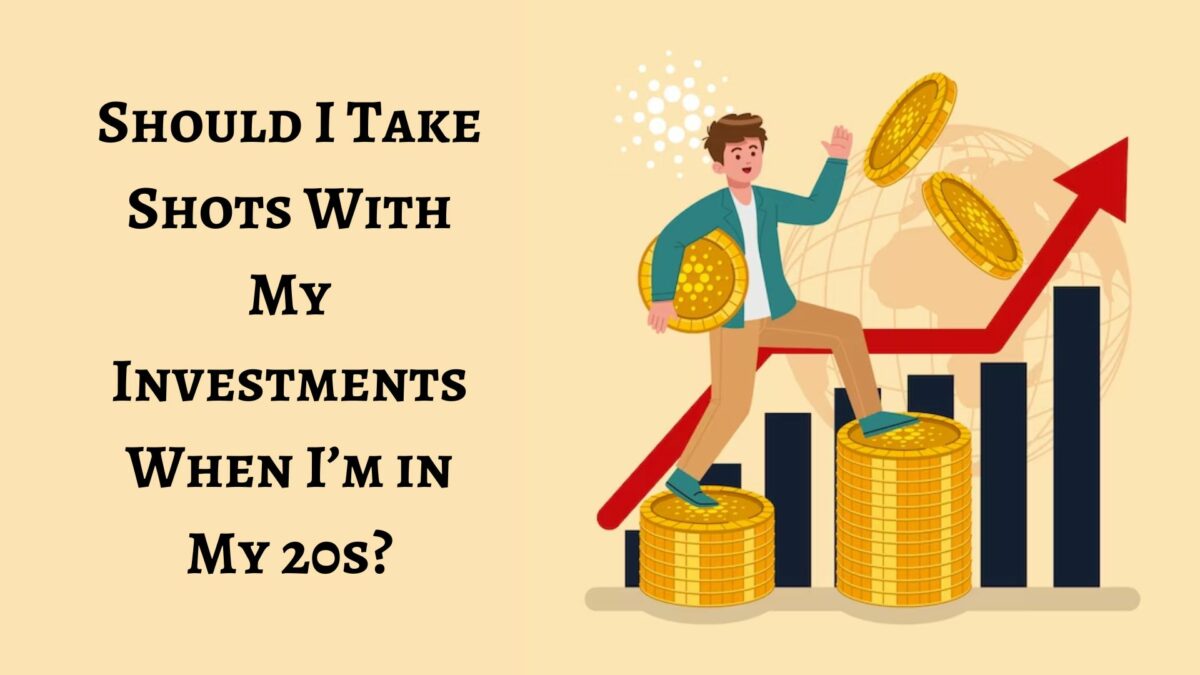Risk comes from not knowing what you’re doing.”
– Warren Buffett

“We will either find a way or make one.”
– Hannibal

I recently read the story of Sam, who became a millionaire by age 30. He has a ton of great life lessons in there (skip down to the part titled “Some Thoughts on Building a $1 Million Nest Egg Before 30”) about what sort of work ethic it takes to get ahead.
One of the points that he brings up is that at age 22, he invested $3,200 and turned it into about $200,000. He admits he was lucky (after all, you do, statistically speaking, have to be lucky to beat the markets, particularly over time), but that enormous boost gave him the platform from which he was able to turn that $200,000 into over a million dollar net worth in another six years – no easy task in itself, either.
Of course, for every Facebook or Tumblr founder, there are a lot of people who take shots and wind up failing with those shots. When I first started investing, I took a shot and watched it bleed away to $0 when the stock I invested in declared bankruptcy. I then waited until my early thirties to take my next shot, and I eventually was able to grow and then sell my business and achieve financial independence.
So, I am a walking example of what Sam discussed, even if I took my shot a little later in life. When taking the shot works, it’s great.
But what happens when taking the shot doesn’t work?
For the Sams out there, there are many more anti-Sams, people who think that they know what the next big thing is before the rest of the world catches on, only to find out that the world already knew what they didn’t, and their swing-for-the-fences money shrinks substantially. If they go all in when they’re young, does it really help or hurt them in the long run?
To evaluate this, I created a model to project into ten thousand different futures. This is called Monte Carlo modeling, and it uses random number generation to forecast what would happen given a set of scenarios.
In this case, I decided to create three parallel scenarios. All of these involve someone who is currently age 26, has $5,000 a year to invest, and will work no later than age 65. The ideal target “retirement number” is $2 million (to read why the target number isn’t necessarily the retirement goal to focus on, check out “Why You Shouldn’t Obsess Over Your Net Worth”):
- Scenario 1: Invest the $5,000 per year in the market and achieve market returns. The average S&P 500 historical return since 1871 has been 10.6%, with a high return of 56.8% and a low return of -44.2%. The simulation generated a random number averaging 10.6% and ranging somewhere between the high and the low return.
- Scenario 2: Between ages 26 and 30, take a swing-for-the-fences shot. Invest all $5,000 in a speculative investment that had a 10% chance of a positive return between 100% and 1000%, averaging 300%. When the “shot” failed, the loss ranged from 0% (breakeven) to -100% (losing it all), averaging a loss of 30%. Remaining money, e.g., the returns on the “shots,” was reinvested in the stock market.
- Scenario 3: The same as Scenario 2, except if one of the “shots” had a positive return, thank the Wall Street Fates and stop taking “shots.”
After 10,000 simulations, I looked at how each scenario played out and how our person ended up at age 65.
The person who took no shots wound up with an average net worth of just over $2 million. The median net worth was $1.35 million, meaning that 50% of the scenarios saw this person with less than $1.35 million, and 50% of the scenarios saw this person with more than $1.35 million. The net worth ranged from $72.8k to $33.7 million.
About 65% of the time, our “conservative” person didn’t reach the target net worth.
The person who took shots every year between ages 26 and 30 wound up doing slightly worse, on average, than the person who took no shots. The average net worth was just under $2 million and the median net worth was $1.32 million. That part is unsurprising, because just over 59% of the time, the shots wound up losing money, and the shot taker never had a chance to catch up.
The range of the shot taker was the widest, though. The worst case scenario saw this person with a net worth of $70.3k, but the best case scenario saw this person end up with $38.1 million, due to the rare cases where there were 3 or more successes (approximately 1 in 1000 times).
The shot taker failed to get to the target number slightly more than the conservative investor.
The person who stopped if he had a successful swing at the fences had an insignificant difference in average net worth, again, slightly below $2 million, and $94 worse off than the consistent shot taker. The difference was in the median net worth. The stop if you get ahead person had a median net worth of $1.32 million, but was $5,300 better off than the continual shot taker. The best case of this person was worse, though, topping out at $37.6 million.
The success in reaching the target number was only fractionally better than the whole hog shot taker.
It’s hard to judge from the overall body of work whether or not it’s worth taking a crack. So, let’s look at what happens in the roughly 41% of the time when, according to the scenario I set forth, you take a crack in your late 20s and you hit something.
For the continual shot taker, both the average, at $2.55 million, and the median, at $1.63 million, were much higher.
He also hit the target number about 46% of the time.
The difference was in favor of the person who stopped taking shots once he was successful. The average net worth was $2.56 million and the median net worth was $1.64 million. The average net worth was approximately $4,000 more than the continual shot taker and the median was almost $6,600 more.
The biggest overall difference was in the ability to hit the target number by age 55. Taking shots was about 10% more likely to result in an “early retirement” than not taking shots.
Based on these simulations, it appears that taking shots when you’re young doesn’t have a dramatically negative impact on your overall net worth compared to not taking shots. This is mainly because, relative to what your net worth will be when you’re much older, your net worth is small. A ding won’t hurt that badly. Plus, as we’ve seen in “Sacred Cows Make Great Burgers,”, savings rate is more important than rate of return when it comes to meeting your retirement goals.
Taking a shot does seem to increase your chances of being able to retire early, albeit not by a wide margin, while not drastically impacting your overall ability to retire. While the chances aren’t great regardless of whether or not you take shots, they are slightly better if you do.
The bigger issue may be the psychological impacts of taking shots and not succeeding. As we’ve seen in “Why Past Performance Indicates Your Future Investing Actions,”, Monkey Brain will cause you to take bigger and bigger shots to try to make up for losses. If you’re not cognizant of how he likes to invest, you may go off the rails after a series of unsuccessful shots, taking more and more risk rather than simply ramping up the amount you invest and sticking with relatively conservative investments.
Should you take shots?

It depends on your goals. If you’re looking to retire early or amass a larger nest egg, then you’ll have to take some risks to get there. You could also increase your savings rate, but increasing your savings rate in your 20s probably won’t have the potential upside impact that hitting a ten bagger would.
If those aren’t your goals, or if you just don’t have the psychological makeup to deal with a series of losses (see “Six Reasons Why I am Not Nassim Nicholas Taleb and Neither Are You” for a further discussion of how much capital you need to continue to take losses in search of the home run), then taking a shot seems detrimental to hitting your overall goals. Most of the time, even after you take a series of shots, you won’t have anything to show for your efforts but a losing streak.
If you do want to take a shot, I recommend you stick to the 5% rule, while looking for something with a higher overall potential return.
Shots can work. I’m living proof that they do, and so is Sam, whose story I related in the beginning of this article. They can also be addictive. If your shots don’t succeed, which, statistically speaking, is the more likely outcome, you could convince yourself that it was bad luck, unaligned stars, or a government conspiracy rather than your own shortfalls in investing, and if you become convinced that you have the magic touch and it’ll eventually work out for you, you could find yourself sinking ever greater amounts of money trying to hit it big and make up for your past losses. Swing carefully and don’t keep swinging. Set limits and know when you’re going to quit and take the more conservative route.
Do you take a swing for the fences with your investments? Tell us about your experiences and how they’ve worked out in the comments below!
Author Profile
- John Davis is a nationally recognized expert on credit reporting, credit scoring, and identity theft. He has written four books about his expertise in the field and has been featured extensively in numerous media outlets such as The Wall Street Journal, The Washington Post, CNN, CBS News, CNBC, Fox Business, and many more. With over 20 years of experience helping consumers understand their credit and identity protection rights, John is passionate about empowering people to take control of their finances. He works with financial institutions to develop consumer-friendly policies that promote financial literacy and responsible borrowing habits.
Latest entries
 Low Income GrantsSeptember 25, 2023How to Get a Free Government Phone: A Step-by-Step Guide
Low Income GrantsSeptember 25, 2023How to Get a Free Government Phone: A Step-by-Step Guide Low Income GrantsSeptember 25, 2023Dental Charities That Help With Dental Costs
Low Income GrantsSeptember 25, 2023Dental Charities That Help With Dental Costs Low Income GrantsSeptember 25, 2023Low-Cost Hearing Aids for Seniors: A Comprehensive Guide
Low Income GrantsSeptember 25, 2023Low-Cost Hearing Aids for Seniors: A Comprehensive Guide Low Income GrantsSeptember 25, 2023Second Chance Apartments that Accept Evictions: A Comprehensive Guide
Low Income GrantsSeptember 25, 2023Second Chance Apartments that Accept Evictions: A Comprehensive Guide

